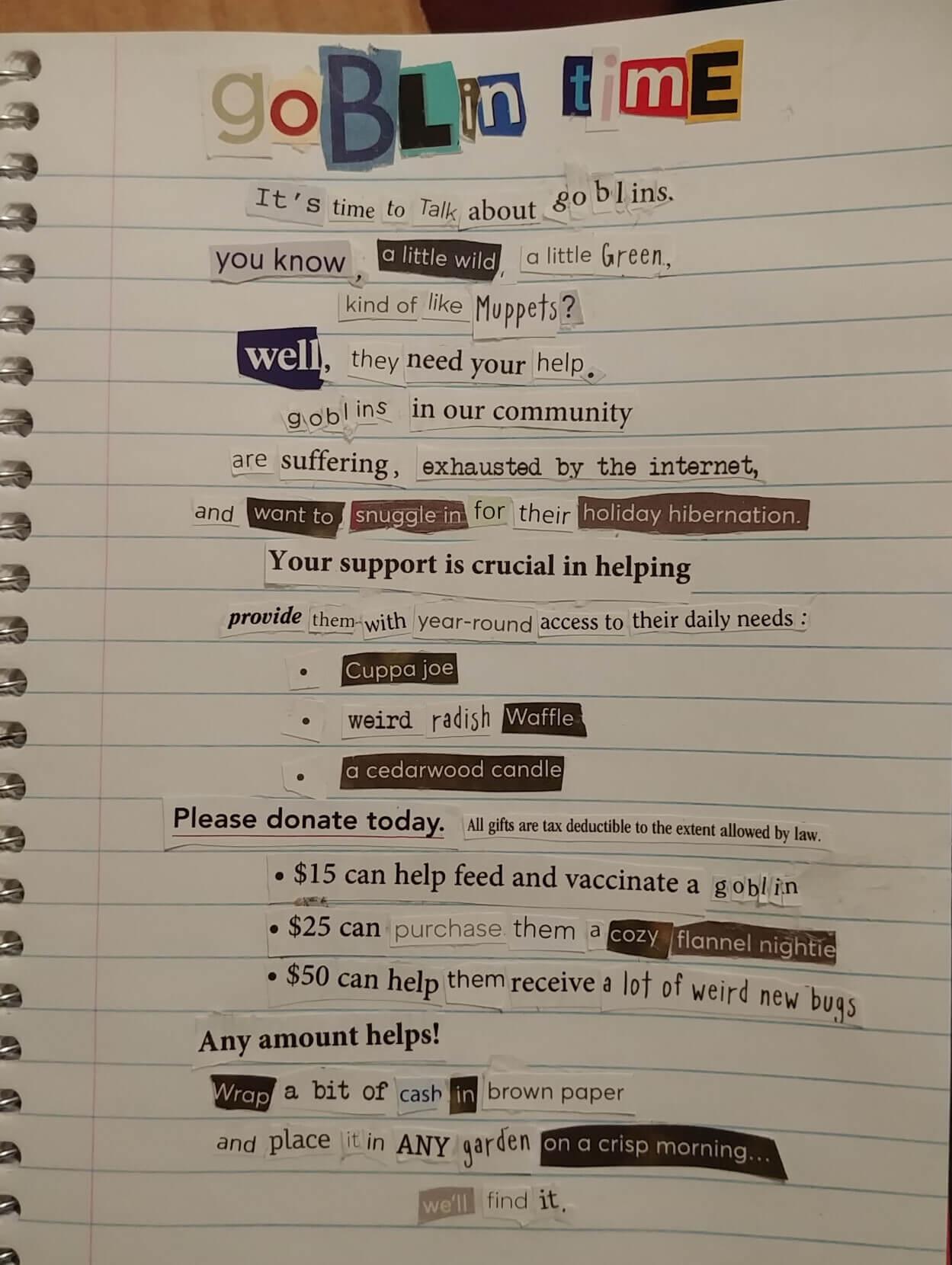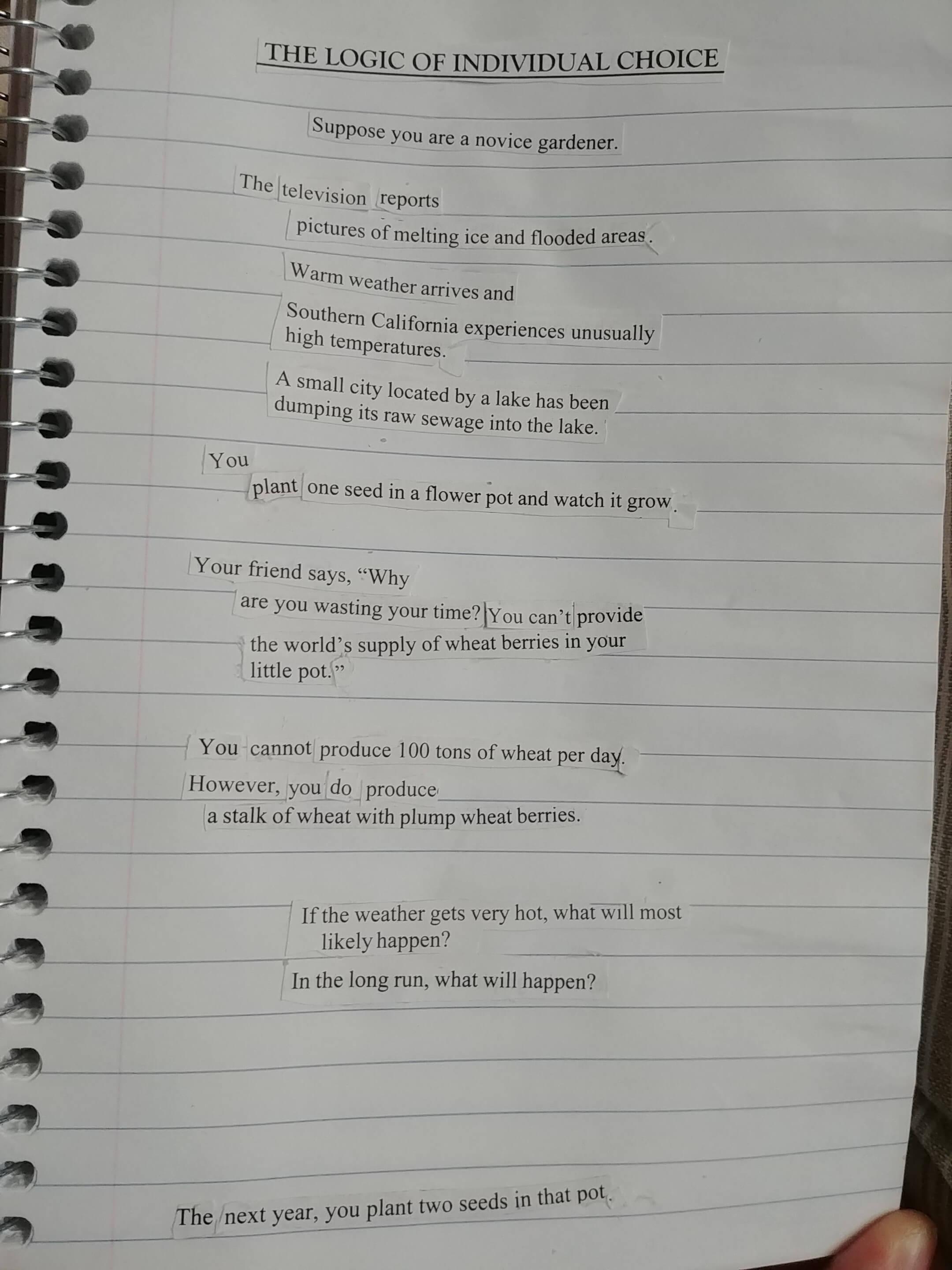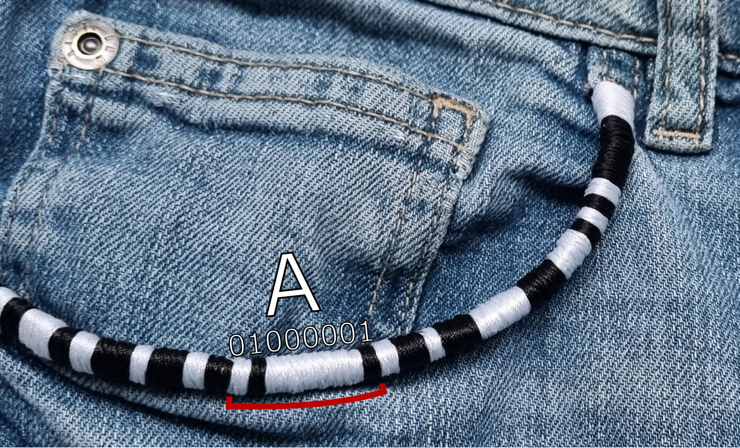FYI - I'm moving fedi software, from microblog.pub to GoToSocial. (I've been running into increasing bugs with microblog.pub lately, and sadly it seems like it is no longer being maintained.) I'm excited to get familiar with GoToSocial, since it seems like a much more mature piece of software while also being lightweight enough to work for my use-case!
As a result, I'll be moving my account over to @emma@fedi.emmajuettner.com, since I can't change the software while still using my social.emmajuettner.com subdomain. I should be able to port over following/followers automatically, so no action required to keep following me-- this is just a heads-up :)
My old server (social.emmajuettner.com) will be taken offline sometime in early January 2024, once I'm confident that the migration has gone smoothly.
I probably won't manage to make anything new for #goblinWeek this year but I will take the opportunity to share the collage poem I made last year, since it is still one of my favorite things I've made
New #collage #poem, about climate change and planting seeds.
This is the second poem I've made by collaging together bits of text from an old econ workbook. (I'm planning to put them all together in a zine when I've completed a few more.)
The first poem, A Bad Dream, can be found here: https://emmajuettner.com/posts/a-bad-dream/
New #introduction now that I've set up my own server— hello, I'm Emma! (previously @emmajuettner@mastodon.art; I'll be migrating my follows over to this new account shortly)
I tend to post about knitting, making collage poems, cooking, creating generative art, mending clothing, tinkering with HTML & CSS, and reading sci-fi stories.
Had another pair of jeans in for repair with frayed pocket openings. This time I decided to alternate the colour of the binding to encode information, with the binding for each eighth of an inch representing one bit, and so each inch representing one ASCII character. I enjoyed this repair, I hope the jeans owner likes it too!
Top down hats for mutual aid, made from scrap yarn I want to get rid of anyway. This orangey one is a dark orange solid sportweight yarn held together with fingering weight yarns. I ran out of the variegated one, and had a bit of trouble finding another in the same weight, but that solid brown worked out well.
(A friend knows people doing mutual aid in western NC, and they’ve asked for warm hats.)
1/2
Folks who run their own site/blog, did you know that you can add alt text to the images that show up on social media when your articles are shared?
og:image:alt
twitter:image:alt
Knitted metasurfaces! Absolutely wild, straight out of ~2000s speculative fiction.
I would like a Christmas jumper that doubles as a passive radar antenna array.
https://techxplore.com/news/2024-11-blanket-sophisticated-radio-frequency-antennas.html
Here, you look like you could use some bunnies. #knitting
@platypus my bank used to allow custom security questions, so I set one to "what are you wearing?" and the answer to "that's very inappropriate please transfer me to your manager". the first time an customer service rep encountered it they couldn't stop laughing and had to actually transfer to a coworker to complete the call.
cursed idea that crossed my mind at work today: SonarQube Wrapped
"this year, the category of code smell you pushed most frequently was Cognitive Complexity > 15"
"you added more unit tests than 90% of your coworkers"
etc.
An exciting discovery: the air in my home gets extremely dry in the winter and it irritates my nostrils, but I just had the idea to take one of my cloth masks from the early days of the pandemic, run it under some water, and then put it on. Now any air I breathe in is passing through a layer of damp cloth first, so it's like an extremely localized humidifier. (I have an actual humidifier too, but this solution has a much more immediate effect)
Repair culture, thrifting, gift economies are hugely important to fighting the #climatecrisis. I've admittedly never been a shopper--I don't get the hit of pleasure with new stuff--but I *did* associate repair/thrift with poverty (my parents grew up very poor and stridently put that behind them as they rose to lower middle class), so I understand *all of this* is cultural programming. And we have to deprogram.
1/2
Robin on Robin
This time I was ready and waiting 🙂
#Robin #RobinSculpture #BirdFeeder #Lucky #Photography #Vogel #Rotkehlchen
We report: the sunset is revealing clouds that were too thin to see during the day. The light is catching them from below, like a last-minute attempt to get attention on what the sky was doing today. It is working for us. We watch the clouds fade back into dusty blue.
Behold the wonderful animated gifs of the artist Alex Khabbazi
he individually knits each frame
The result: A gorgeous glitchy blend of the analog and digital
Item #1 in my latest "Linkfest" newsletter, free to read and subscribe to here: https://buttondown.com/clivethompson/archive/linkfest-27-aztec-death-whistles-supercircular/
Futzle Industries presents:
A Christmas Wasted With Deb Pickett
A musical extravaganza of bad song parodies and original doggerel, including:
• Space Parity (I’m on Hold to Telecom)
• Pooper Scooper
• I’ve Written a Self-referential Major General Parody
• Brillo, Spit-Brillo
• Clank! I Just Thought of the Romans Again!
Plus one or two Christmas songs.
Streaming on #RadioFreeFedi Saturday 21 December 2024, evening for the western Pacific, morning for Europe (oh god o’clock for the Americas), which also happens to be both the solstice and Saturnalia [CLANK] 0️⃣.
A Song for Black Friday
Woim 🪱
@Meyerweb
Ex-cashier here ...
Please place heavy stuff in the middle of the belt so it doesn't stress the cashier's wrist causing carpel tunnel. Light stuff on the outside and small on the inside. All coupons placed with the product so the cashier doesn't have to hunt for the product to see if it matches the coupon.
And never make a cashier pull items out of basket. The stress on their wrists and fingers causes painful life long injuries.



























